The Best Harness for Cats
When it comes to picking out a cat harness, there are lots of styles to choose from. The best harnesses for cats keep a cat’s physiology in mind, though, and suit their smaller frames. In my experience, Puppia brand harnesses have consistently been the best cat harness for my pets. Designed with smaller pets in mind, Puppia (and their dedicated line for cats, Catspia) makes comfortable, reliable travel harnesses in a variety of sizes, styles, and patterns. Here, I’m sharing details about the Puppia Back-Clip Harness, and detailing why this easy-to-use style is the best cat harness available.


Table of Contents:
Shop Top Travel Essentials for Cats
Why You Need a Harness for Your Cat
Whether you plan to leash-train your cat or not, it is a good idea to have a harness (and leash) available in case of travel, moving, or emergencies.
As a lifelong Floridian, I bought my cats’ harnesses originally as part of my annual hurricane prep. It is easier to keep track of a cat in a harness — and, therefore, safer — in times of stress, like when waiting out a lengthy storm.
As for regular travel, keeping a harness on your cat, even when they’re in a carrier, can be an extra layer of safety. This is especially true for air travel, where you’re required to remove your cat from their carrier during security screening. However, even if you’re just driving a few hours in the car, I often feel more comfortable sticking my cats in their harnesses, even if they’re staying zipped up the entire time.
Lastly, harnesses are great tools for moving with cats. When we moved into our house a year and a half ago, I was anxious about acclimating the cats to the new space. I was nervous that they would be difficult to get ahold of or even get out of the house. We were super careful and this did not happen, but after living in apartments with closed hallways for years, I was really afraid of this happening. So, to combat both concerns — about being able to get ahold of the cats and about being able to find them if they got out — we kept our three cats in their harnesses with AirTags for a while after moving in. This alleviated our own anxiety while it allowed the cats to roam the new house in (supervised) peace (pictured below).
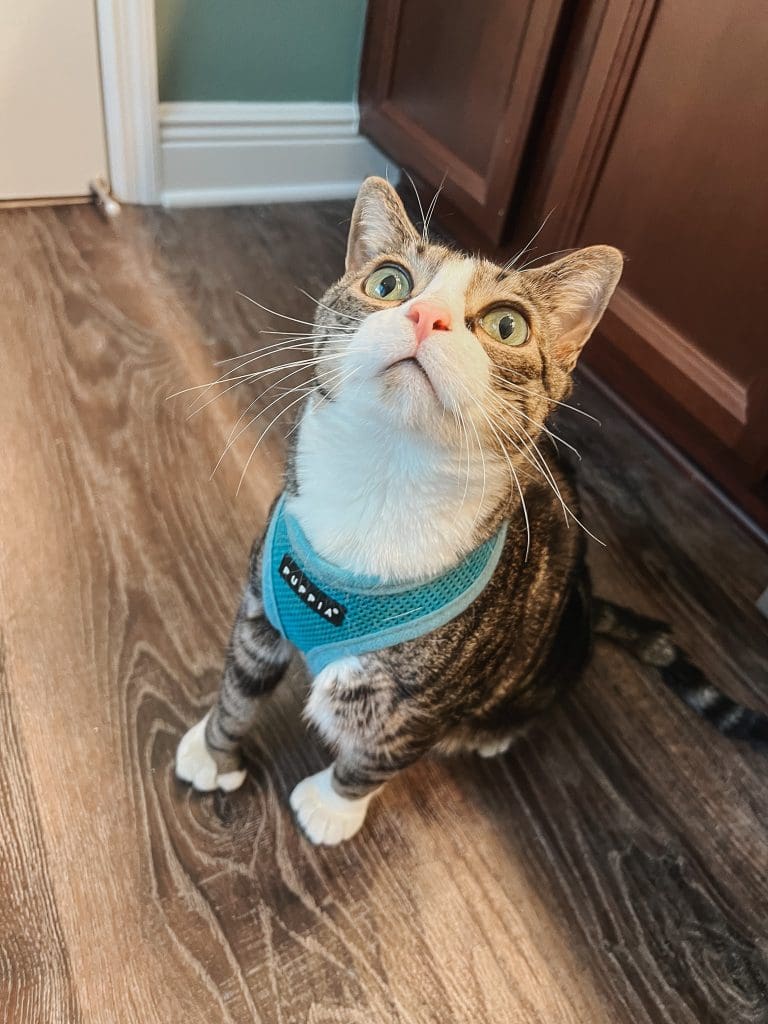
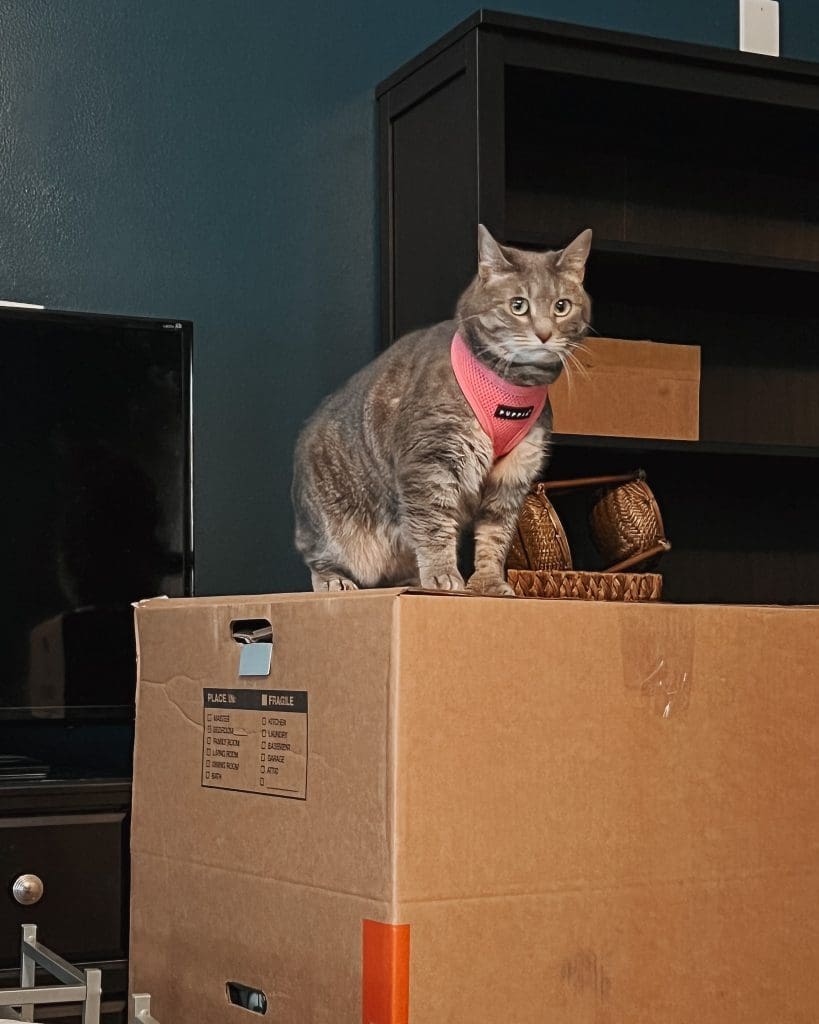
Do you have a move coming up?
Get your furbaby packed and ready with my guide to moving with cats here!
Features to Look For in the Best Cat Harness
Safety Considerations in the Best Cat Harness
When it comes to safety considerations, you’ll want to ensure the harness is appropriately sized and made of durable material. These combine to help make it escape-proof, which you’ll definitely need to keep in mind since cats are notoriously shifty.
Cats have free-floating clavicle bones, or rudimentary collar bones that are not anchored to other bones like our own collar bones. This is why they are able to pass through spaces in which they can fit their heads. Furthermore, a cat’s shoulder blade is attached to the body by muscle, rather than bone, which gives them a lot more rotation and reach with their shoulders.
All that is to say, cats are shifty, so it’s important their harness fits tightly enough to be escape-proof.
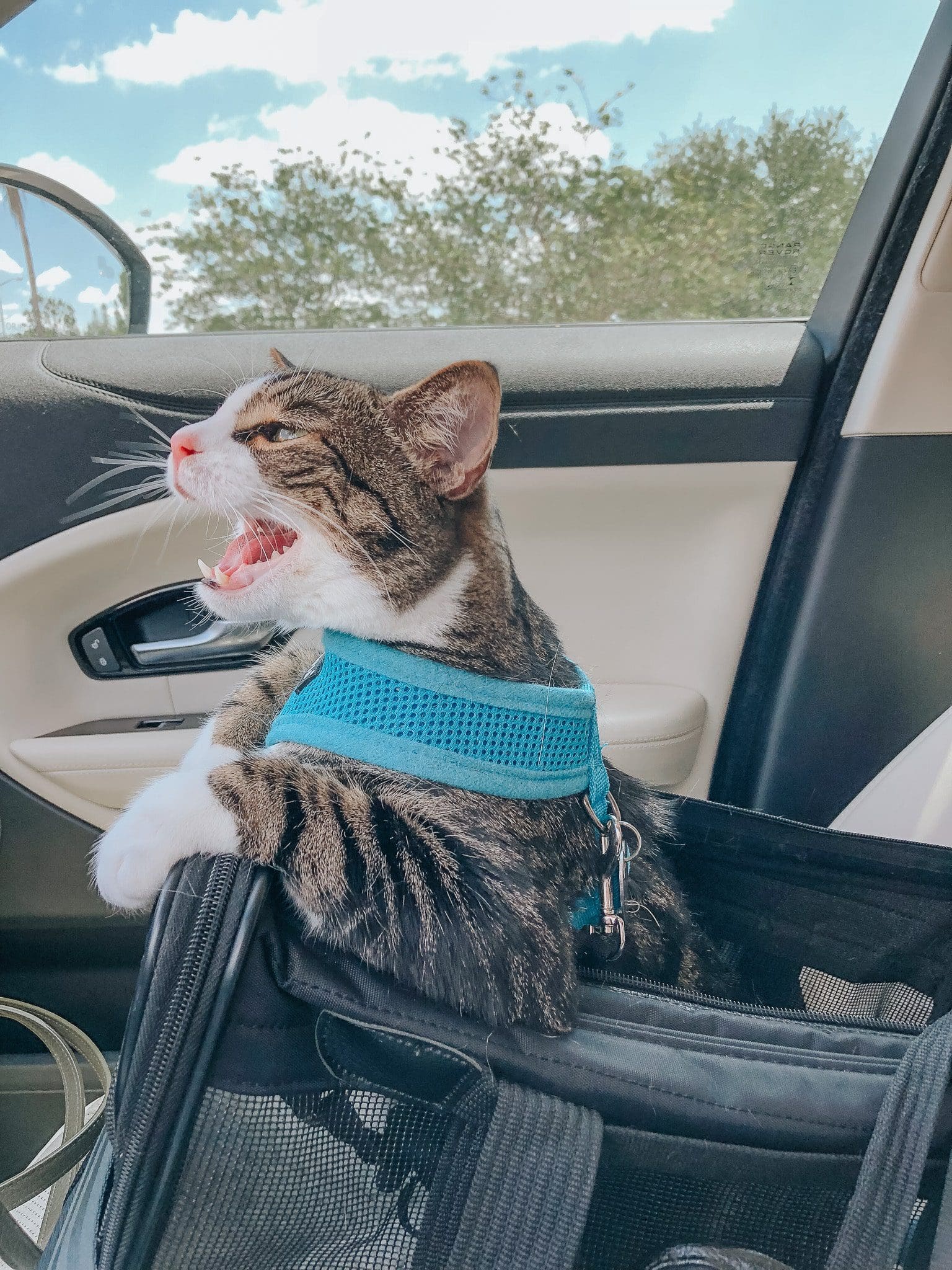
Cat Comfort and Sizing Considerations for Harnesses
While it is important for a harness to be snug enough, it should not be overly tight. There should be freedom of movement for the cat, and a too-tight harness will restrict their movements and be potentially dangerous. Furthermore, the material should be comfortable and, ideally, padded.
When determining the most comfortable size for your cat’s harness, you’ll need to measure your cat with a tape measure before you order a harness. The important measurements to take will be around their neck and upper torso.
The Puppia Back-Clip Harness (the best cat harness in my opinion) has sizes as small as 7.5 inches around the neck and an adjustable 9-12.5 inches around the torso. In my experience, the small sized harness (designed for 9.5 inches at the neck and an adjustable 12-18 inches at the torso) is suitable for most cats. My cats range from 11 lbs to 14 lbs, and all three fit into Puppia size smalls.
Why the Puppia Back-Clip Harness is the Best Cat Harness
When I bought my first cat harness for Louis, there weren’t a ton of options on the market. Harnesses for cats were still pretty rare. I was originally introduced to the Puppia Back-Clip Harness by Adventure Cats, who used to sell the harnesses. Now, there are a variety of styles of harness, including vests (of which the Puppia Back-Clip Harness is one) and even jackets.
That being said, back-clip/vest style cat harnesses have always worked well with my cats. The Puppia Back-Clip Harness fits them well, is easy to put on over their heads, and securely snaps around the waist. While I generally have help getting the cats into their harnesses, I like that this style is easy to slip over the cat’s head and maneuver on my own.
The material of the Puppia harness is easy to clean, offers comfortable padding, and is quite durable. I have had Louis’ harness for over eight years now. I did have to reinforce his harness at one point because the seam on the back loop began to fail, but I’ve had no issues beyond that. The Puppia harness I purchased for Olivia approximately five years ago has never had such an issue.
Adding an AirTag to the Harness
Another reason I like the Puppia harness is that it’s relatively easy to add an Apple AirTag to. Using a rubber AirTag holder like this, you can slip the holder over the waist band and it’ll stay snug and secure against your cat’s torso. You can see the AirTags affixed to my cats’ harnesses in the images below.
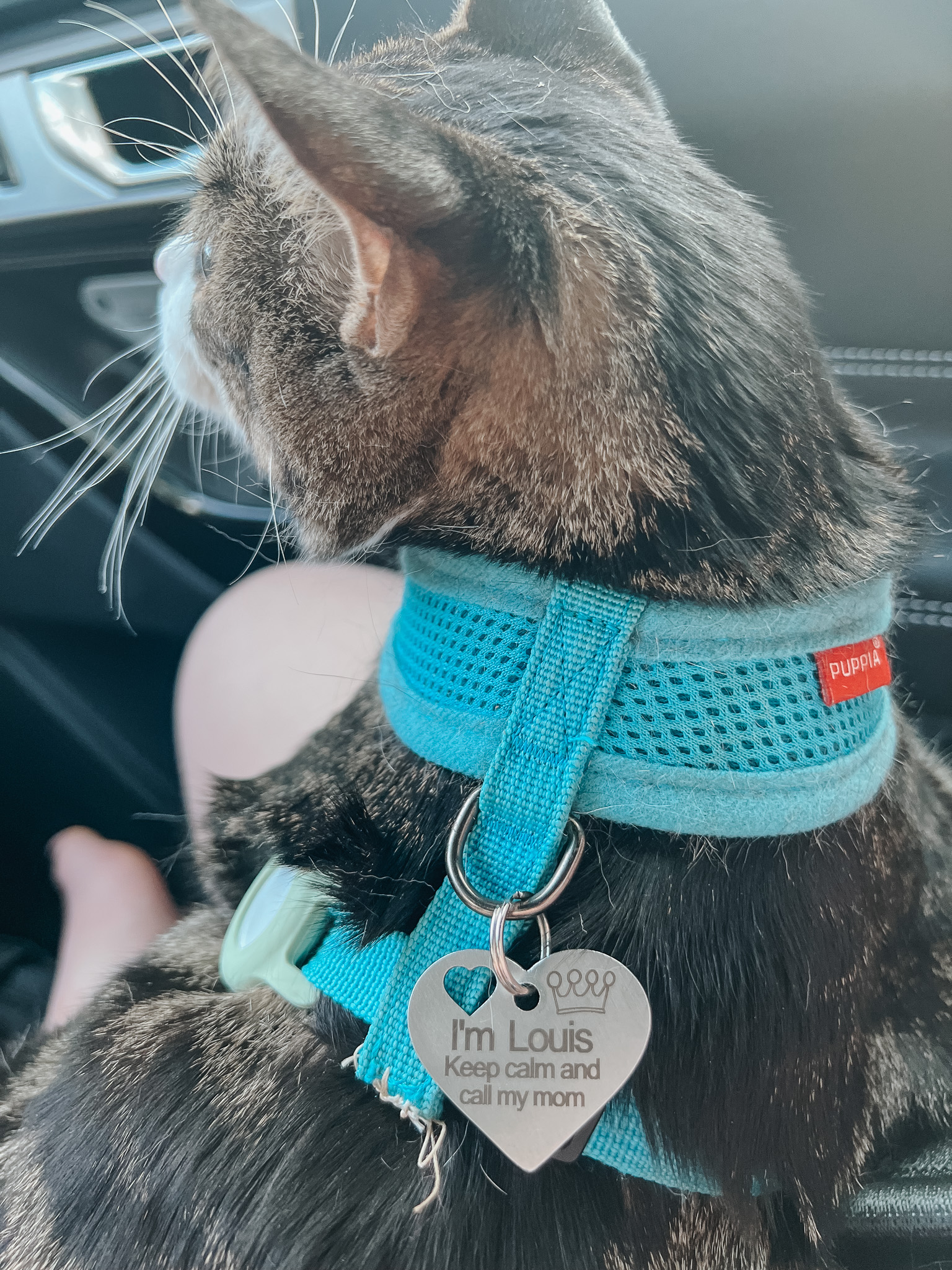
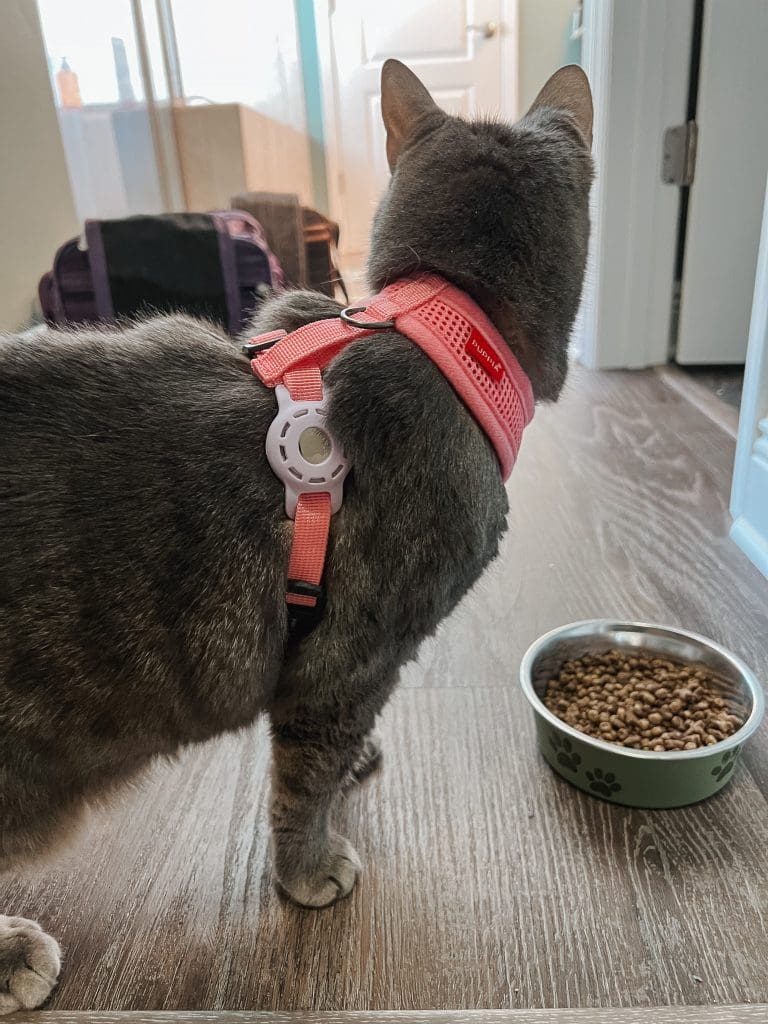
While they seem small to us, AirTags are kind large compared to the typical cat, so I like this option better than a collar or harness that has the tag up against their necks; it seems like it would be more comfortable around their torsos than against their necks and chins.
Introducing Your Cat to a Harness
Earlier, I mentioned that your cat should have freedom of movement in their harness. It may take a moment to determine if this is the case, because some cats act rather dramatically when they are first put into a harness. Cats may squat down, army crawl, or — like Louis has done on many occasions — simply plop over, as if they cannot walk.
If this is the case with your cat, give it a minute and try to coax them to move around. The reflex to freeze is pretty common, but tends to go away as the cat gets more acclimated to the harness. If you know you’ll be needing your cat to be comfortable in their harness for some time — before going to the airport, for example — it can be a good idea to slowly introduce wearing the harness over a period of time. Put the cat in the harness for ten or fifteen minutes and interact with them; play with their favorite toy, entice them to follow you around, and so on. This helps them get comfortable with the otherwise foreign object. If they’re anything like my cats, soon, they’ll be bounding around without even realizing they’re wearing it!
Shop the Puppia Back-Clip Harness
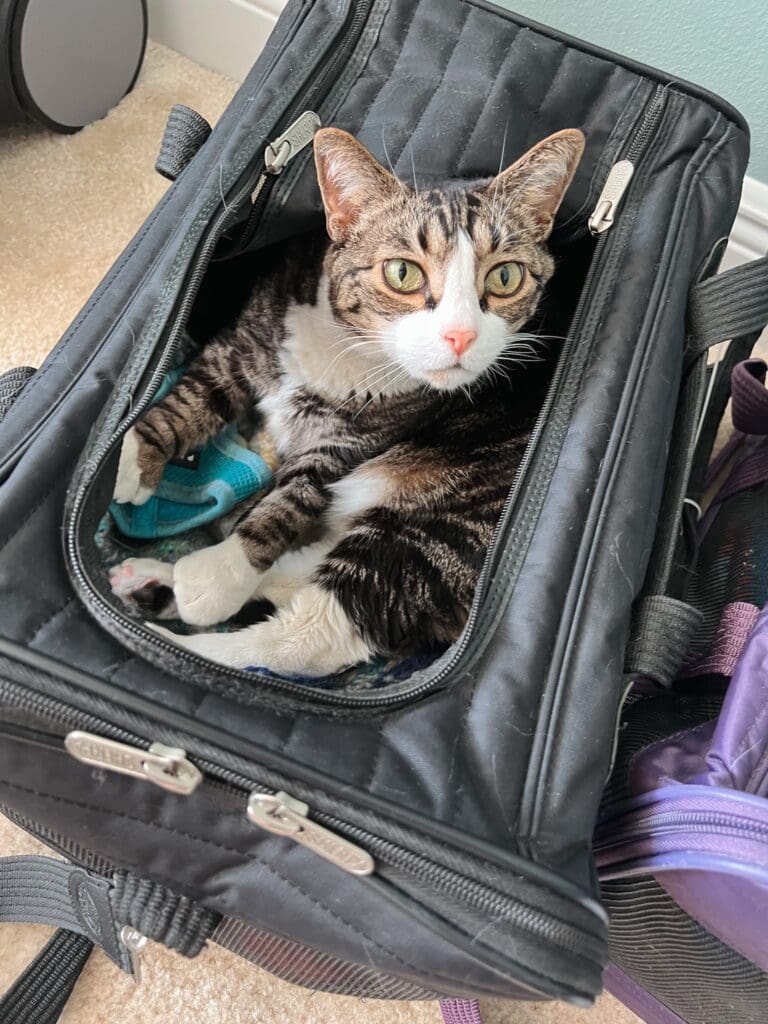
Now that you have your cat’s harness sorted out, be sure their carrier is up to snuff!
Get all the details on the best cat carrier here!
Whether you’re adopting your first cat or adding to your clowder,
my Cat Care Guide covers everything you need to know about giving your cat their best life!
Check out my full Cat Care Guide here!



I have a Ragdoll cat who likes to hang out on our patio with us. We always put him in a harness and on a leash. He was such an escape artist at first, and broke many of the cheap type harnesses. While he doesn’t fight it anymore, I think I might get one of these for him because they look so much more comfortable than the ones I’ve been able to find locally. Great information – thanks!
I think one of these Puppia harnesses would work great for your Ragdoll! It gives us cat parents such great peace of mind, too.